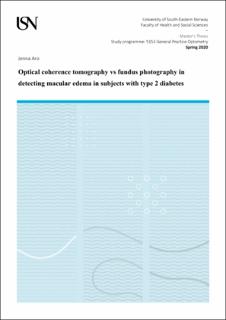| dc.description.abstract | Introduction
The screening of diabetic retinopathy has been relied on fundus photography but since it is 2-dimensional, it is difficult to identify diabetic macular edema (DME), which is the most feared ocular complication related to diabetes. Optical coherence tomography (OCT) has been shown to be a useful tool in detecting and monitoring DME.
The main objective of this study was to screen people with type 2 diabetes and find out how many patients have current diabetic macular edema and to compare different screening equipment by means of fundus photography and OCT when evaluating macular edema.
Method
The sample of this study consisted of people with type 2 diabetes who participated in the larger cross-sectional study “Diabetes, vision and ocular health” at University of South-Eastern Norway. Participants were examined in National Centre for Optics, Vision and Eye Care at University of South-Eastern Norway in Kongsberg between August 2018 and February 2019. OCT images (HD-OCT Cirrus 5000, Carl Zeiss Meditec, Germany) and fundus photos focused on macula (Kowa nonmyd 7, Kowa Europe GmBH, Germany) were obtained on the same day. The collected OCT images and fundus photos were evaluated on different days to avoid bias. Presence of DME in fundus photography was based on definitions of Multi-Ethnic Study of Atherosclerosis (MESA) and in OCT on retinal thickness and findings in macular cube 200X200. The evaluated area was in correspondence with the ETDRS (Early Treatment Diabetic Retinopathy Study group) grid 1-3-6 in both fundus photo and in OCT image.
Results
A total of 74 subjects with type 2 diabetes (mean [SD] age 65.28 [9.79] years, 35 women, 39 men) were included in the study. Based on optical coherence tomography (n=123 eyes), DME was found in 10 (8.1%) eyes of total 8 (11.4%) subjects. With monocular fundus photography (n=136 eyes), DME was detected from 8 (5.9%) eyes of total 6 (8.6%) subjects. Clinically significant macular edema was found in 4 eyes (3 subjects). Some images, both OCT and photos, were excluded due to insufficient image quality or the macular conditions interfering with the evaluation of the macula.
112 eyes had both gradable fundus photo and OCT image and were included the analysis when comparing imaging methods. The inter-rater reliability between fundus photography and OCT was calculated by using Cohen´s Kappa in SPSS. Computed kappa was 0.596 which indicates moderate agreement.
Conclusion
The prevalence of DME in this sample seems to be in correspondence with global estimations in the literature. This was a cross-sectional study of a diabetic population, and the number of eyes with DME were low. To draw any statistical conclusions about which imaging techniques of OCT and fundus photography that are most reliable to detect DME, further testing including more subjects is warranted. However, the results indicate that OCT detects more cases with edema, and both diffuse and early stage of edema seemed to be harder to define from the photos | en_US |
